Planning a 3-day Ireland itinerary using only public transport can be a pain in the backside… So, we’ve done all of the hard work for you!
We’ve spent 25+ years travelling around Ireland…
The itinerary below has taken that experience (and the many mistakes we made along the way) to create an itinerary that we’re confident you’ll love!
In a nutshell, this 3-day itinerary:
- Has been meticulously planned for those only using public transport
- Has an hour-by-hour itinerary for each day to save you time/hassle
- Follows logical routes that take you to hidden gems, tourist favourites and great pubs and restaurants
Who this itinerary will suit
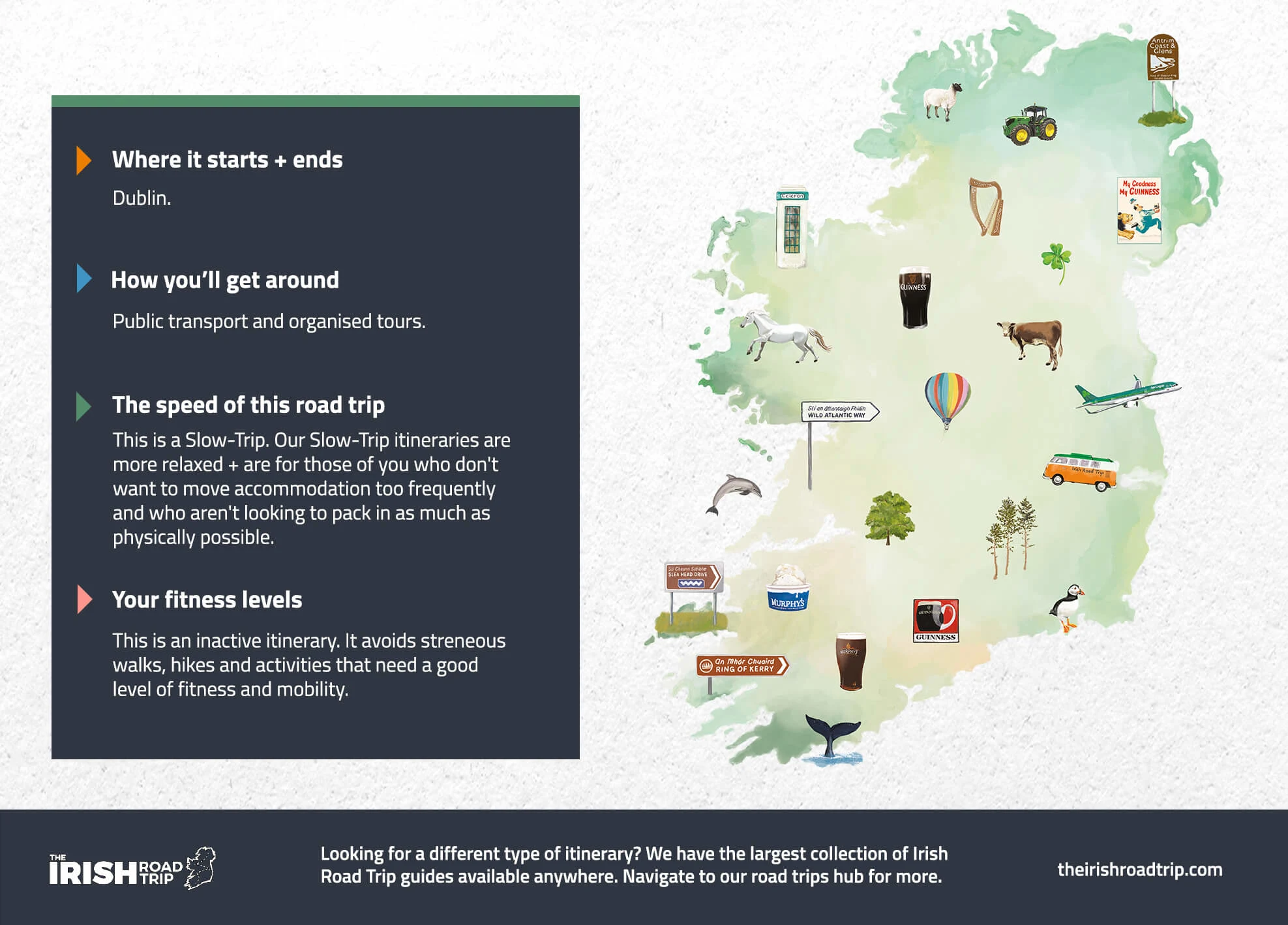
Now, before you scroll down, take 10 seconds to look at the graphic above – each of our road trip itineraries have been tailored to specific needs.
This road trip is specifically for those of you:
- Starting in/near Dublin
- Using public transport and organised tours
- Looking to explore at a slow pace
- With a low level of fitness (i.e. it avoids long walks and hikes)
- Remember, we have hundreds of different itineraries here if this one doesn’t suit you.
An overview of this 3-day Ireland itinerary

It’s important that you take a look at the graphic above as each of our road trip itineraries have been tailored to specific needs.
It uses several bases (e.g. Dublin for 3 nights) and provides you with day-long road trips you can head off on, so you avoid having to change accommodation constantly.
Now, I’ll stop rambling on – here’s a day-by-day insight into each of the days below!
Day 1: Arrive in Dublin

Photos via Shutterstock
Day 1 of this 3-day Ireland itinerary is going to be very dependent on the time that you arrive into Dublin.
For this itinerary, we’re going to make an assumption that you’ve landed in the morning and are ready to explore from mid-afternoon.
Recommended accommodation in Dublin
- Budget: Abigail’s Hostel (Temple Bar), Jacobs Inn (central hostel) and the Generator Hostel (short walk from the city)
- Mid-range: Dublin Skylon Hotel (just outside the city), Wren Urban Nest (Temple Bar) and the Harding Hotel (very central)
- Luxury: The Merrion (St. Stephen’s Green – very central) and The Westin (just off Grafton Street)
Getting around Dublin + money savers
- Time savers: If you want to avoid walking where possible, it’s worth getting a ticket for the Hop On Hop Off Bus around Dublin. It goes to or near all of the main sites on this itinerary plus plenty more.
- Money saver: If you’re visiting the ‘main’ Dublin attractions, the Dublin Pass can save you €€€ (here’s how)
Stop 1: Lunch

Photos © Tourism Ireland
There’s plenty of great restaurants in Dublin that serve up a delicious lunch, but if you fancy a tasty bite in a lovely old-world-style pub, Neary’s just off of Grafton Street is hard to bate!
They serve simple dishes (like soups and sandwiches) that are packed with flavour and great value for money. Alternatively, Sprout and Co. on Dawson St. is also a great choice.
They have a range of hearty salad bowls, with good options for vegetarians and vegans.
Stop 2: Trinity College

Photos via Shutterstock
Now you’re all fuelled up, it’s time to head to Trinity College to see the Book of Kells, arguably the most famous cultural attraction in Dublin.
If you can, we highly recommend pre-booking your tickets online, as the queues can get really long (bordering on ridiculous!). This fast-track ticket allows you to dodge the queue and gets you into Dublin Castle, too!
Spend around one hour seeing the Book of Kells, walking around the exhibit, and taking in the beauty of the Old Library. After that, give yourself another 20 minutes or so to walk around the university campus.
Stop 3: The Ha’penny Bridge (via Temple Bar)
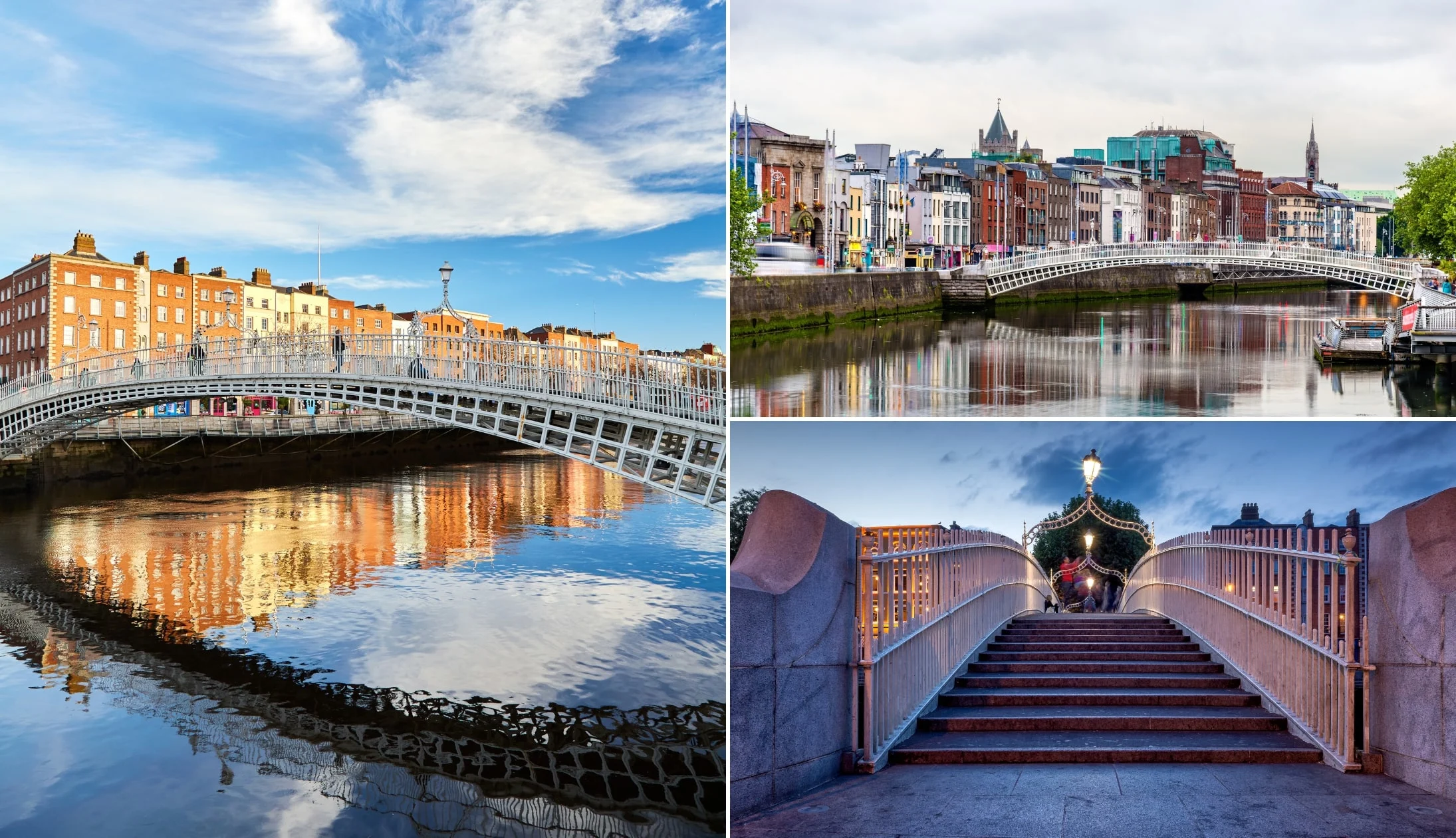
Photos via Shutterstock
The Ha’penny Bridge (officially named the Liffey Bridge) dates back to 1816 and was the first pedestrian bridge over the River Liffey!
It’s a seven-minute walk from the Trinity Gates, but feel free to take your time as you make your way through the lively streets of Temple Bar.
Now, Temple Bar can be a bit of a tourist trap. If you fancy a pint, here are several pubs in Temple Bar worth trying (the Palace is our go-to).
If you feel like an afternoon coffee, there are some great cafes in the Temple Bar area or on the other side of the river. Joe’s Coffee and Vice Coffee are two of our favourites across the water.
They’re both just a short stroll from the north side of the Ha’penny Bridge.
Stop 4: Dublin Castle
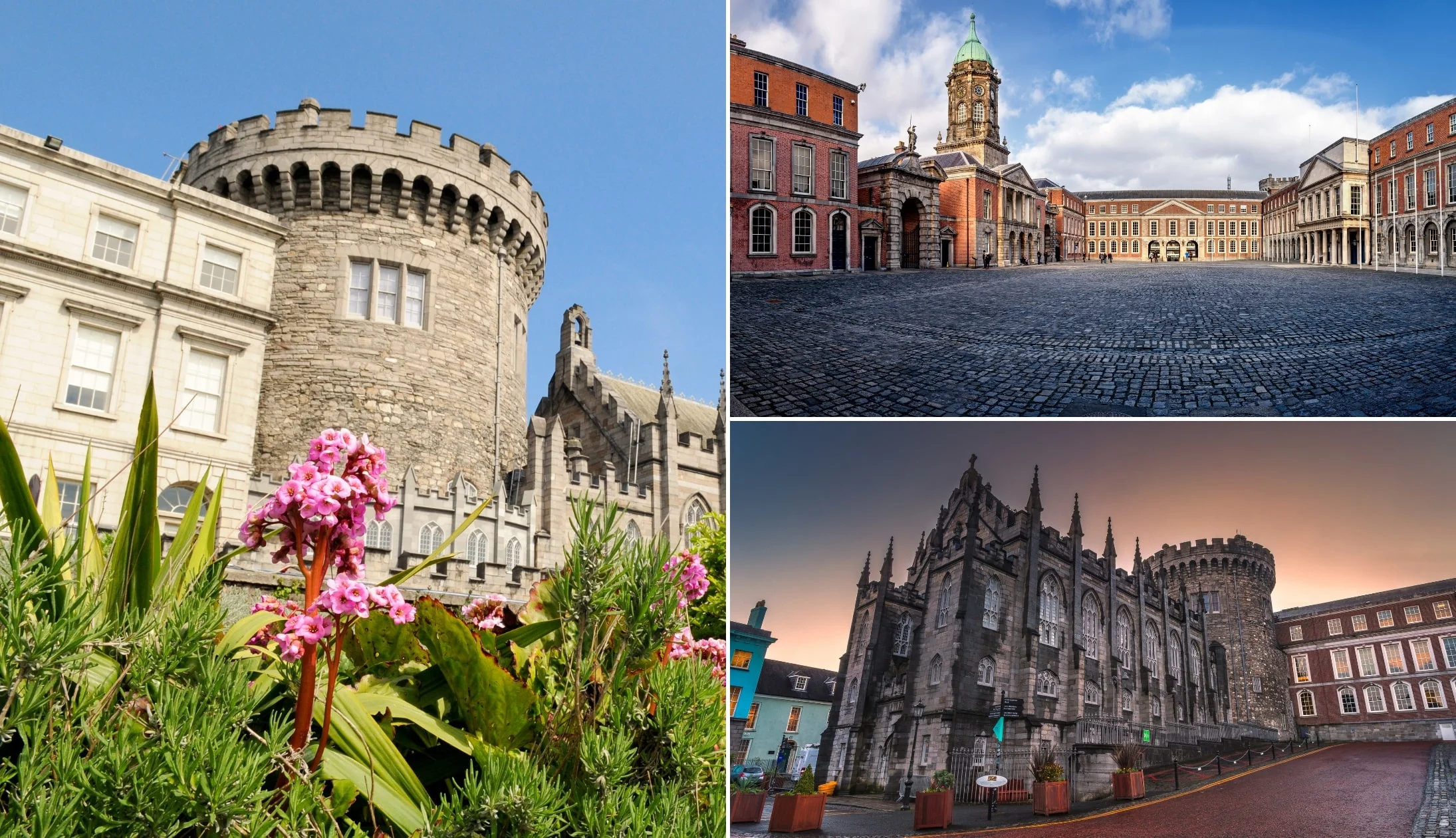
Photos via Shutterstock
Next on the itinerary is Dublin Castle. Nestled in the city centre, the castle dates back to the 13th century and was the seat of the English for over 700 years.
Today, it’s an important government complex and the site of Presidential Inaugurations and key State events. The castle is around 10 minutes from the Ha’penny Bridge on foot.
There’s no admission fee to explore the grounds, but if you want to have a look inside you’ll need to purchase tickets for either a self-guided tour or a guided tour.
Guided tours include access to the State Apartments, Exhibitions, Chapel Royal, and the Mediaeval Undercroft. Self-guided tours include access to the State Apartments and Exhibitions only.
Tickets for guided tours can be purchased on the day of your visit at the ticket booth.
Stop 5: Christ Church Cathedral
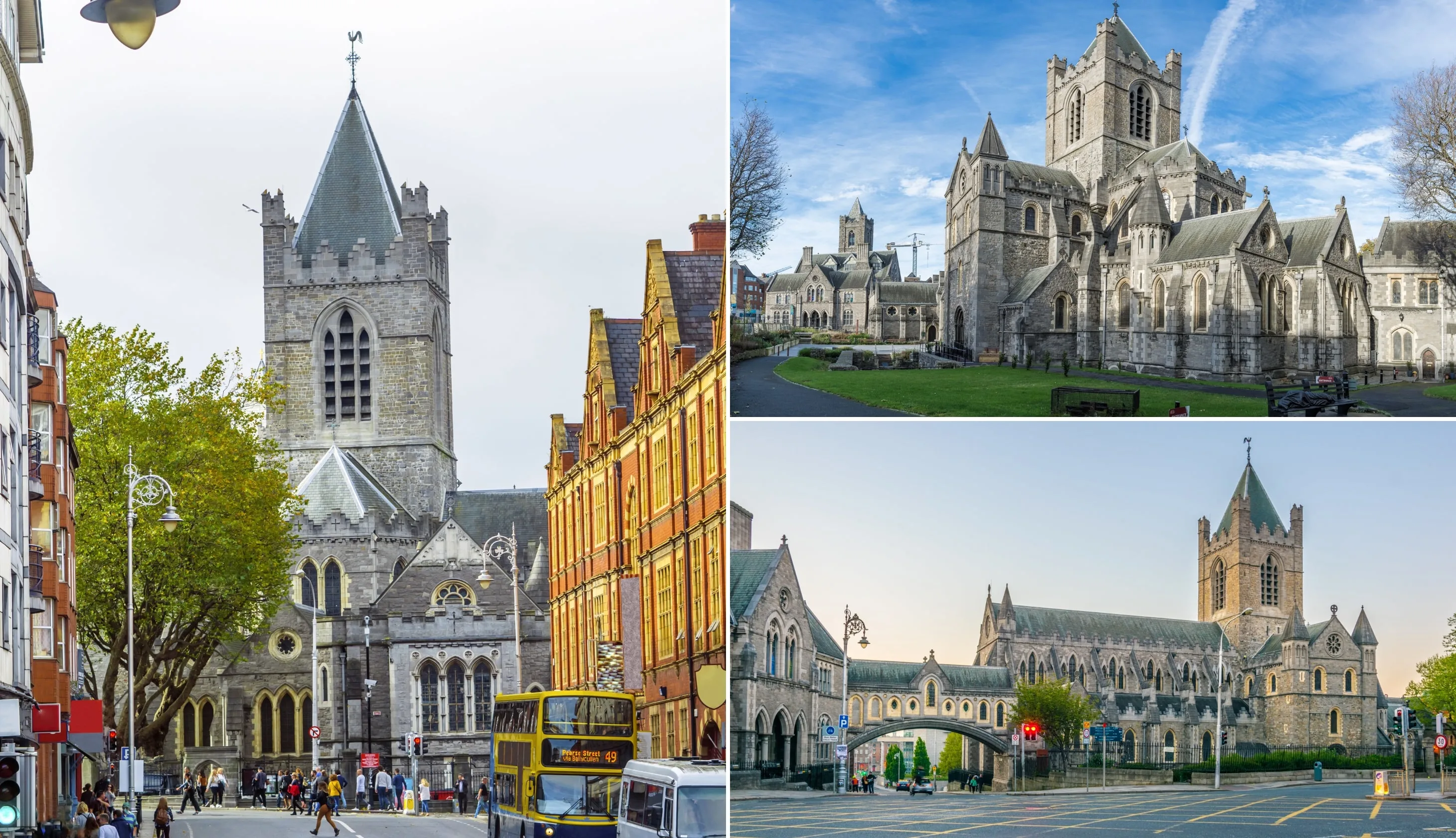
Photos via Shutterstock
Christ Church Cathedral dates back to the early 11th century when it was founded under Sigtrygg Silkbeard, a Norse King of Dublin. It was rebuilt later in stone, largely thanks to the first Anglo-Norman archbishop, John Cumin, in the late 12th century.
The cathedral is only a 4-minute walk from Dublin Castle and a really interesting place to visit. Some highlights are the restored crypt houses, Strongbow’s tomb, and the Treasures of Christ Church exhibition.
You can grab a ticket online here – these include an audio guide that comes in several languages, with three themes to choose from – ‘Power and Politics’, ‘Music and Spirituality’, and ‘Christ Church and the City’.
Self-guided tours with an audio guide usually last around one hour.
Stop 6: Dinner, drinks and live music
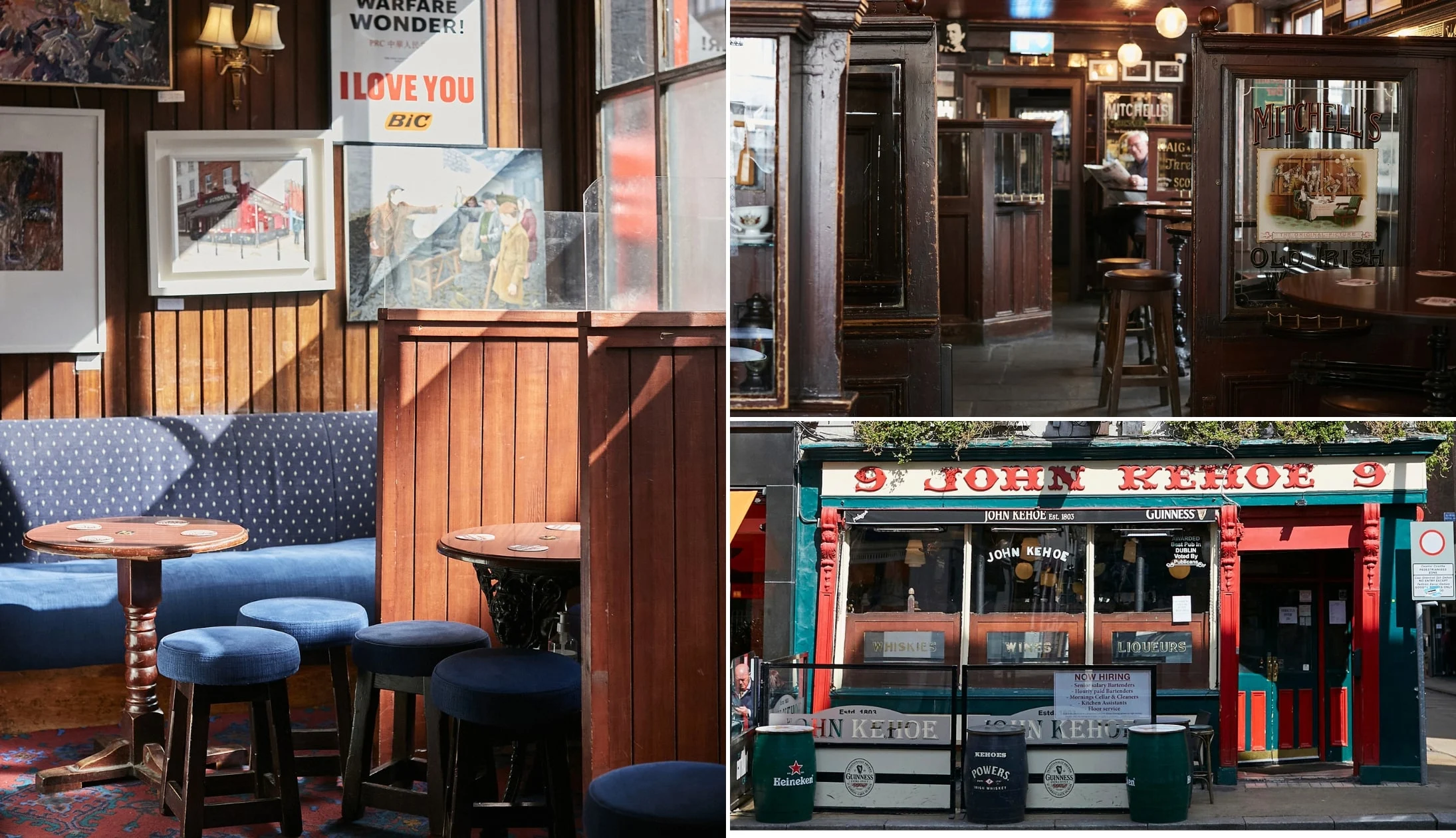
Different trad bars in Dublin. © Tourism Ireland
By now you must be getting hungry. Dublin has heaps of options for dinner, but we’ve got a couple of suggestions for you!
Our dinner recommendations
If you’re looking for something close by, Spitalfields is a short walk from the cathedral. It’s a little bit pricey, but the atmosphere is great and the food is top-notch!
However, Spitalfields is 16+ only, so it’s not suitable for young families. Otherwise, check out The Bull and Castle across the street from Christ Church Cathedral.
Their menu has F.X. Buckley Steaks (renowned in Dublin), plus a great selection of local craft beers. The restaurant can get booked out pretty quickly, but you can always eat in the bar upstairs, which also has steak on the menu.
Live music and trad bars
If you want a taste of what Dublin’s best pubs are, see our detailed Dublin pubs guide. If you’re solely looking for places that do exceptional Guinness, see our guide to Dublin’s best pints.
If you fancy a bit of live music, there’s plenty on offer. Pipers Corner on Marlborough St. has some great tunes, with live music from 9pm every Tuesday to Saturday, and from 8pm on Sunday.
The inside has more of a modern feel, but you’ll be guaranteed authentic Irish music.
For the full experience, O’Donoghues Bar on Merrion Row has live music every night of the week. It’s about as traditional as Irish pubs get, with a brilliant atmosphere.
The Celt is another fantastic pub with live music every night from 9pm, although it’s not always traditional.
Day 2: Mighty Meath and Louth

Photos via Shutterstock
On day 2 of the 3 days in Ireland itinerary, you’ll be heading out to County Meath, known for its archaeological sites.
It’s another jam-packed day, so make sure to have a hearty breakfast and to pack some snacks in case you get peckish on the road.
Today’s 10-hour organised day trip leaves from the same spot, near the Molly Malone statue. There aren’t too many breakfast options open this early, so once again, we recommend Keoghs Cafe as they open at 6am.
Keep reading below for an overview of the tour, but please note that 1, you may not always physically stop at all of these sights and 2, these tours are subject to change, so always check with the provider in advance.
Stop 1: Hill of Uisneach

Photos via Shutterstock
The Hill of Uisneach is an ancient ceremonial site that’s home to numerous monuments and earthen artefacts.
It’s an interesting spot that’s steeped in folklore, and according to Irish mythology, the hill is the centre of Ireland and where everything began!
At the site, you’ll find a conjoined ringfort, arguably the most important monument on the hill, a monument known as St Patrick’s Bed (stood at the highest point on the hill), and the Stone of the Divisions, a group of stones said to mark the exact centre of Ireland.
Stop 2: Fore Abbey
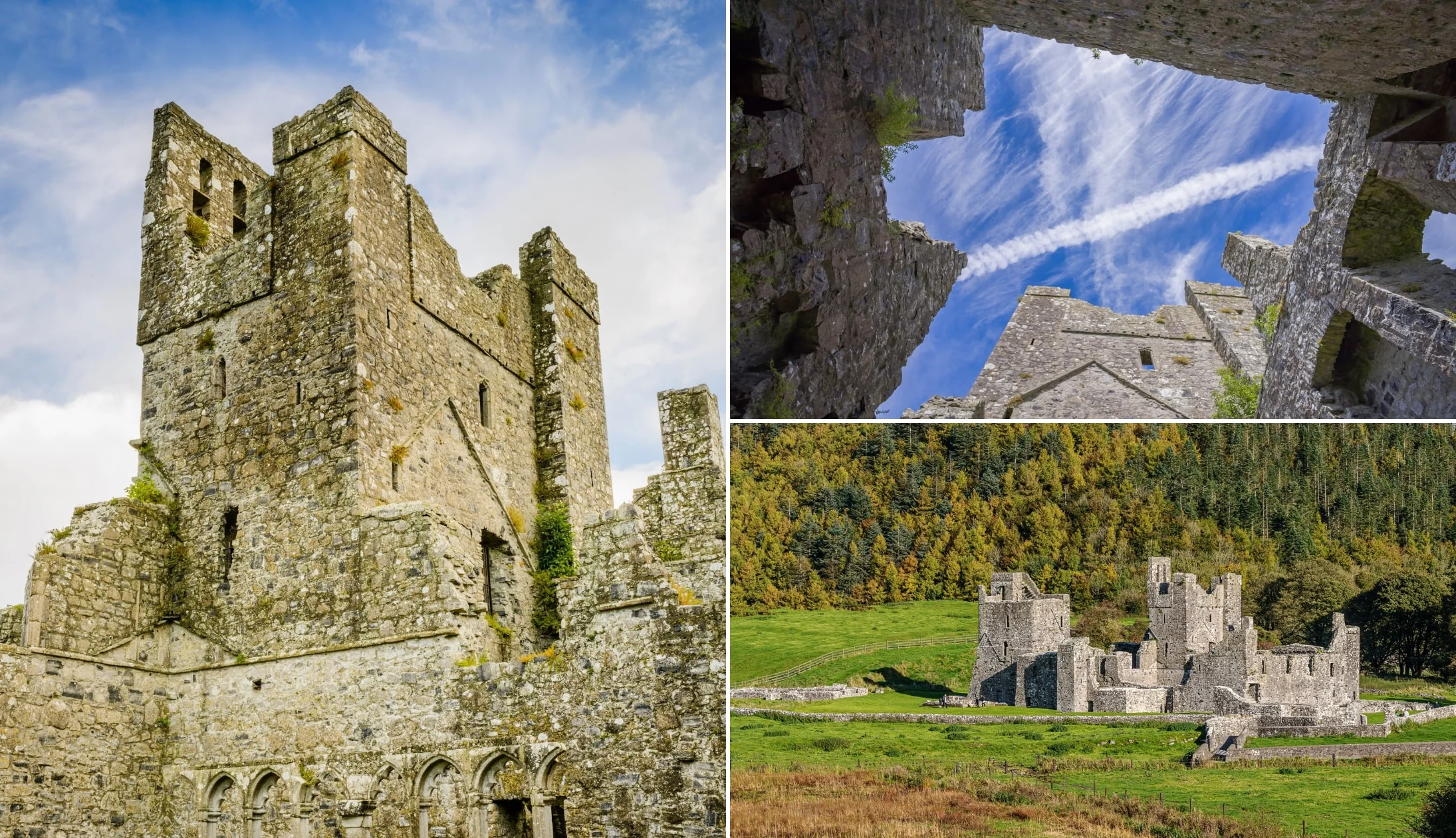
Photos via Shutterstock
Fore Abbey is the ruin of a Benedictine Abbey founded by St. Feichin in the 7th century. The ruins are in good condition with several features that are still visible to this day, including St. Feichin’s Church which was built in 900 AD.
The abbey is known for its legendary “Seven Wonders of Fore”. These are the monastery in the bog; the water that flows uphill; the tree that has three branches; the mill without a race; the water that doesn’t boil (in St. Fechin’s holy well); the anchorite in a cell; and the lintel-stone raised by St. Fechin’s prayers.
Aside from the wonders, Fore Abbey is also well known for the Fore Crosses, 18 crosses that are spread out over 10km.
Stop 3: Loughcrew Passage Tombs

Photos via Shutterstock
The Loughcrew Passage Tombs, or Loughcrew Cairns, are a group of neolithic passage tombs that date back to 3000 BC.
Cairn T is the largest of the tombs and can be seen from many miles away. It contains magnificent examples of neolithic art and is perfectly aligned to the sunrise during the spring and autumn equinoxes.
Like Fore Abbey, this site is also entangled in folklore. According to local legend. The huge throne-like boulder (nicknamed the Hag’s Chair) on the Cairn’s north side, was the seat of an old witch!
Please note that the walk up to the cairns is very steep and may prove difficult for those with low levels of fitness.
Stop 4: Trim Castle

Photos via Shutterstock
Trim Castle is Ireland’s largest Anglo-Norman fortification. It’s very impressive with an imposing presence that’ll catch your eye from afar as you approach the town.
The Castle dates back to the 12th century and took Hugh de Lacy and his successors 30 years to complete.
The tour of Trim Castle is well worth it, especially for any Braveheart fans, as parts of the movie were filmed there!
If you have time, take the stroll out to the large tower ruins on the hill past the castle (you can’t miss them). You’ll get a great view of the castle from afar from this point.
Stop 5: The Hill of Tara
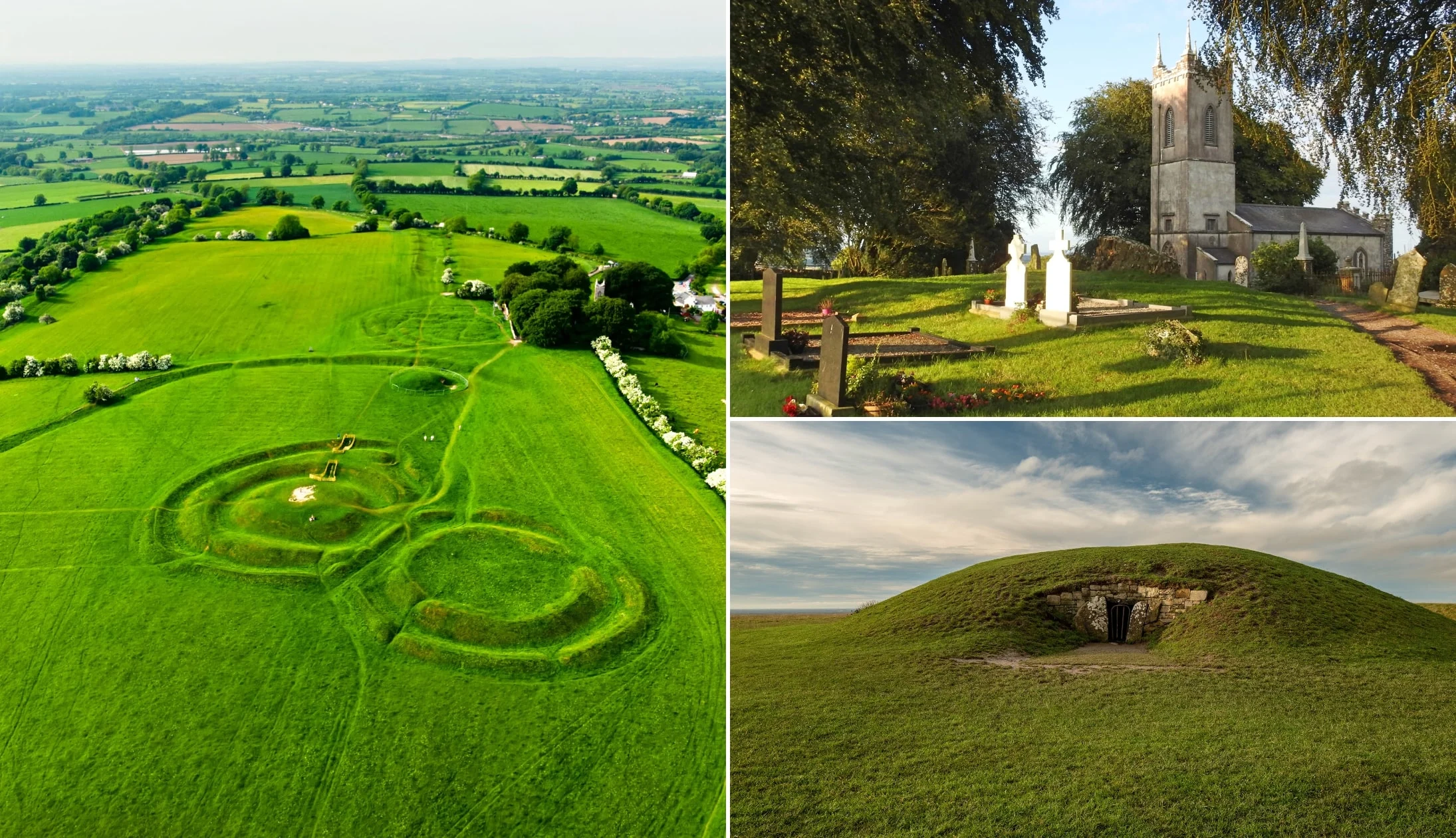
Photos via Shutterstock
The Hill of Tara has been in use since the late Stone Age, but it’s known best as the seat of the High Kings of Ireland, with all old Irish roads leading to the site!
The site is shrouded in myth, and the story of Conn of the Hundred Battles tells the tale of how the High Kings of Ireland came to be.
It’s free to visit, with a free 25-minute Audio Visual Show at the visitor centre (in the church) and free guided tours scheduled every day.
Stop 6: Back to Dublin for the night

Different trad bars in Dublin. © Tourism Ireland
From the Hill of Tara, it’s a 50-minute drive back to Dublin City Centre (depending on traffic).
We’ve got some more dinner and drinks suggestions for you tonight. For dinner, head to Pickle on Camden Street to experience Indian food like never before.
If you feel up to it, get the five-course tasting menu which starts at €60 per person.
For drinks, head to Doheny & Nesbitt or Searson’s (both on Baggot Street). These are both traditional Irish pubs with cosy snugs.
Finally, for great music, we suggest The Merry Ploughboy (it’s a little outside the city in Rathfarnham, but you can get a €10 return shuttle). Or, if you want to stay inside the city, head to the Old Storehouse in Temple Bar.
Day 3: Depends on how much time you have

Photos via Shutterstock
So, the final day will depend on how much time you have and if you’re actually leaving on the third day.
If you are leaving, you can take the Dublin Express from the city centre out to Dublin Airport. The bus has multiple stops around the city centre, and if traffic is good, can take as little as 15 minutes.
If you have the full day 3 to explore, I’d recommend this 8-hour day trip to Wicklow that takes in the Sally Gap and some of the most scenic corners of the county.
And that’s a wrap on this road trip
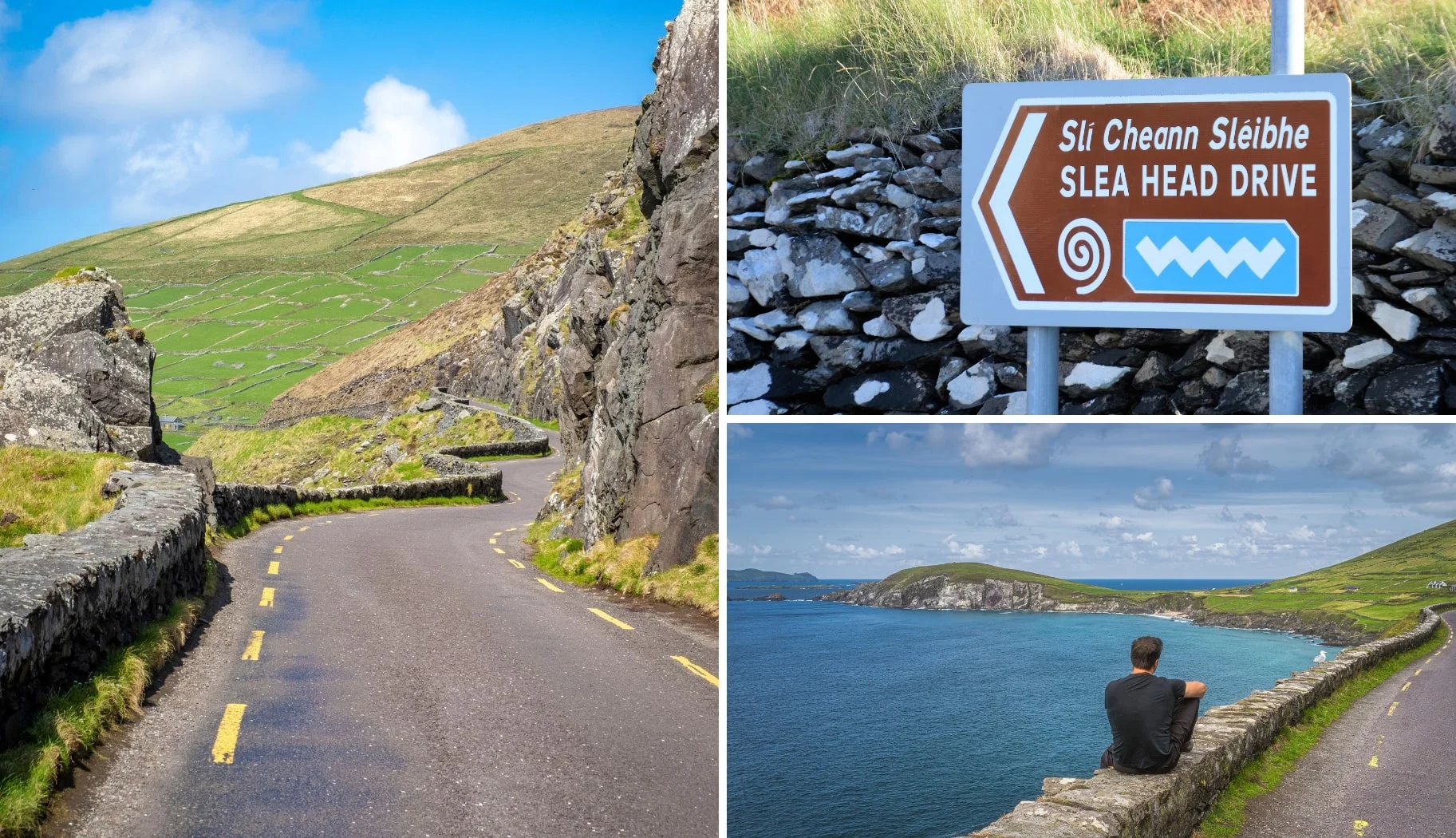
Photos via Shutterstock
We hope you found the above road trip guide useful. If you have any questions, ask in the comments below and we’ll do our best to help.
Or, if you’d like to browse our other Irish Road Trip itineraries, visit our Road Trip Hub – cheers!
Keith O’Hara has lived in Ireland for 35 years and has spent most of the last 10 creating what is now The Irish Road Trip guide. Over the years, the website has published thousands of meticulously researched Ireland travel guides, welcoming 30 million+ visitors along the way. In 2022, the Irish Road Trip team published the world’s largest collection of Irish Road Trip itineraries. Keith lives in Dublin with his dog Toby and finds writing in the 3rd person minus craic altogether.


